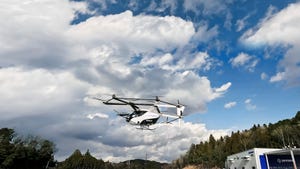Rethinking Smart Manufacturing for the New NormalRethinking Smart Manufacturing for the New Normal
Smart manufacturing has surged in relevance. But making the concept a reality requires cultural consensus.
May 26, 2020

Key Takeaways from This Article:
As the global economy stalls, manufacturers have an opportunity to plot a future course.
Smart manufacturing programs have gained in popularity, but broad-based support for them remains elusive.
Organizations seeking to become data-driven should know the limits of their data-gathering capability.
While the manufacturing forecast is bleak for the remainder of 2020, global economic malaise provides an opportunity to chart a new course.
While many manufacturers continue to hope for a return to normal, leading organizations have taken a longer view. They have retooled to succeed in an environment marked by extraordinary uncertainty and rapidly changing consumer demand.
One factor that could separate winners from losers is the former’s willingness to “play by the new rules for the long term,” as Silicon Valley investor Roger McNamee wrote in 2004. “In the new normal it is more important to do things right than to succumb to the tyranny of urgency.”
While there is no shortage of frameworks and technological tools promising to help guide manufacturers’ chart a future course, manufacturers must create a resilient, agile and data-driven culture to make use of them. Manufacturers need a proverbial north star that can guide them beyond the current chaos.
Rethinking Products and Processes
The silver lining to the unprecedented uncertainty is that it provides an ample opportunity for reflection. Manufacturers and other asset-intensive organizations should rethink their operating risks from top to bottom, said Dan Miklovic, an analyst at the Analyst Syndicate. That could include making the supply chain more resilient and identifying long-term strategies to keep workers safe. “The first thing you need to do is get your digital business model correct,” said Nitin Kumar, CEO at Appnomic and former consultant at FTI Consulting.
While manufacturers have been bombarded with promises that technologies from augmented reality to artificial intelligence will help them future-proof their business, manufacturers with stalled technology deployments should reevaluate those investments, Miklovic said. Similarly, organizations considering automation and advanced control systems should minimize the operational risk they might pose. Allowing remote access to an automation system could solve a short-term problem but create long-term cybersecurity vulnerabilities without proper security controls, warned Martin Davis, managing partner at DUNELM Associates.
As smart manufacturing programs gain relevance, manufacturers should prioritize driving support for them. “The biggest problem is not that people don’t know what to do. It’s that cultural antibodies work to kill anything new,” Kumar said.
Manufacturers should revisit long-held talent acquisition strategies as the remote working paradigm gains traction for workers. Manufacturers have traditionally grappled with “decades-old perceptions about their industry [being] only for manual workers,” as PwC noted. While many manufacturers have struggled to find skilled data- and digital-savvy workers in the past, the uptick in remote working improves talent access, as McKinsey has observed.
But identifying new talent won’t necessarily spark transformation if an organization lacks high-quality operational data.
“First, you must have access to the right data to support smart decision making,” said Michael Tay, advanced analytics manager at Rockwell Automation. Next, the question is how to use data automatically so that data-driven operations become entrenched in everyday processes. “A lot of industrial equipment, especially brownfield equipment, has limited connectivity,” Tay said. “But with newer sensor technology and connectivity, it is a lot simpler to add data-collection capability.”
Still, creating data-driven industrial systems takes more than sensors, Davis stressed. “It is crucial to understand the context of that data and how that data can be used,” he said. “Only by doing that can it become useful information and drive the right decisions.”
Still, data science tools have limits. For one thing, they are best suited at solving tractable problems. “It’s very difficult to cover swings in consumer demand” with modern data tools, Tay said. “There are so many unmeasured things and externalities that drive behaviors.”
Still, many manufacturers have been forced to accommodate erratic shifts in consumer behavior. Some organizations are retooling product lines to respond to a sudden uptick in demand in health-care goods.
Consumer-facing manufacturers should also ask themselves how they can revamp existing products that respond to long-term shifts in consumer behavior. A company making buses or trains, for instance, could create defined ventilated zones within vehicles that also allow passengers to distance themselves from others.
Another trend relevant to the manufacturing sector is a growing emphasis on “virtual everything,” said Danny Smith, vice president, industry advisory and principal, industrial sectors at Ceridian in a webinar from the National Association of Manufacturers. Touchless, virtual reality and augmented reality technologies are all set to surge, he predicted.
While devising novel products and services is a priority for many manufacturers, some struggle to market them once they are launched. “Digital products or services are usually sold into the C suite,” Kumar said. “Their current salesforce is often not equipped to have that conversation with a different economic buyer and on a different level than they are used to.”
Charting Your Own Course
Experts are divided when it comes to recommending a north-star metric to guide manufacturers through these times of crisis and beyond. Davis points to the Industry 4.0 philosophy, which is a German smart manufacturing framework that integrates approaches such as lean manufacturing with supporting technologies such as the Internet of Things to cloud computing to artificial intelligence. “It is far more than just technology,” Davis said.
“Industry 4.0 does not have to be technically complex or expensive,” Davis said. “It starts simply with a focus on data to make better decisions.” “Becoming increasingly data-driven seems like a very cost-effective way to make the next stage in performance,” Tay said.
Data savviness is also a prerequisite for measuring the effectiveness of digital initiatives. “Organizations must leverage data to measure improvements on independent, targeted metrics” throughout an initiative’s lifecycle, Tay said. “First, identify the business targets, then benchmark them and track them over time.” In essence, every time a stakeholder makes a critical decision provides an opportunity to track its outcome using digital resources. “Look for important decision making that remains driven by tradition or guesses,” Tay said. “That’s where you’ll discover your next strategic initiative.”
Miklovic said flexibility should be a guiding principle. “Investment plans should be prioritized toward projects and initiatives that deliver maximum agility,” he said. Many industrial organizations possess sufficient digital technology to improve flexibility, Miklovic stressed. “They just need to use it more effectively.”
No matter what metric a manufacturer chooses to guide its transformation, it’s not likely to succeed unless it is embedded in an organization’s culture. “If you want to become a digital-savvy organization, you need to embed digital into your organization,” Kumar said. “If you have a separate digital division within your organization, that creates a problem because the legacy businesses don’t have an incentive to change.”
About the Author
You May Also Like





